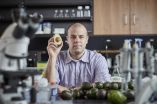(Press-News.org) This news release is available in German.
ETH material engineers found that the performance of ion-conducting ceramic membranes that are so important in industry depends largely on their strain and buckling profiles. For the first time, scientists can now selectively manipulate the buckling profile, and thus the physical properties, allowing new technical applications of these membranes.
"Ionics, ion-based data processing and energy conversion, is the electronics of the future", says Jennifer Rupp, a professor of Electrochemical Materials at ETH Zurich, and therewith sums up her field of research. Together with her group, Rupp produces ceramic materials that can conduct charged atoms (ions), such as oxygen or lithium ions, very quickly. Such materials are already being used today; for example, in lambda sensors of automotive catalytic converters and solid oxide fuel cells. The ETH professor is convinced that the industrial importance of these materials will even further increase - for example, in gas sensors, new classes of data storage and computer circuits, and in the conversion of chemical energy into electrical energy and vice versa.
One of the most important research questions in Rupp's field currently is how to optimise these materials, which are usually produced in the form of a thin membrane, so that ions can move more quickly within them. In a study just published in the scientific journal Nature Materials, several doctoral students in her group demonstrated how ion transport depends greatly on the manner in which these membranes are strained. The group also succeeded in controlling the strain of the membranes selectively, which is a breakthrough in the development of future technical applications.
Free-standing membrane
The scientists worked in their study with a very thin ceramic layer; namely, gadolinium-doped ceria. "This is one of the most frequently used ion conductors in the industry," explains Sebastian Schweiger, a doctoral student.
In previous research, the material had been usually studied in the form of a thin film on a silicon substrate. Yanuo Shi, another doctoral student in Rupp's group and first author of the recently published paper, instead created a free-standing membrane from the material by free-etching the substrate under the thin ceramic layer. The material was then no longer flat but buckled due to changes of the internal stress in the layer during the etching process. Shi attached microelectrodes to small pieces of these membranes to create tiny components that can be used to generate electricity from hydrogen or organic compounds and from oxygen in the air.
Electrode design affects buckling profile
The researchers also found that the arrangement of the electrodes affects the buckling profile of the ceramic membrane and the material structure at the atomic level. In turn, this greatly influences the conductivity of the membrane for oxygen ions. The scientists are able to describe this effect in detail. "For the first time, we are able to selectively control the buckling profile and ion conductivity of such membranes," says Alexander Bork, another doctoral student.
In recent decades, scientists have attempted mainly to influence the conductivity of such ion conductors by deliberately 'contaminating' the material with certain foreign atoms - in technical terms, doping. The ETH researchers have now shown that the conductivity can be controlled to a much greater degree by manipulation of the strain and buckling profile in real devices.
"Even in earlier experiments, scientists noticed that power generation in micro solid oxide fuel cells varies greatly depending on the structure of such cells. In the experiment with the strain of the ion conductor, we have now found a possible explanation for this behaviour," says Rupp. It now appears possible to optimise the characteristics of ion-conducting membranes. This supports the development of future gas sensors, ion-based data storage and micro energy converters, such as fuel cells - and potentially a range of other as yet unknown applications in the promising field of ionics.
INFORMATION:
Literature reference
Shi Y, Bork AH, Schweiger S and Rupp JLM: The effect of mechanical twisting on oxygen ionic transport in solid-state energy conversion membranes. Nature Materials, 15 June 2015, doi: 10.1038/nmat4278 [http://dx.doi.org/10.1038/nmat4278]
WASHINGTON, D.C. - The high seas of Mars may never have existed, according to a new study that looks at two opposite climate scenarios of early Mars and suggests that a cold and icy planet billions of years ago better explains water drainage and erosion features seen on the planet today.
For decades, researchers have debated the climate history of Mars and how the planet's early climate led to the many water-carved channels seen today. The idea that 3 to 4 billion years ago Mars was once warm, wet and Earth-like with a northern sea -- conditions that could have led ...
Researchers who paired Siamese fighting fish in mock fights found that winning fish could supply more energy to their muscles during fights than losing fish.
The findings link the invisible processes going on inside cells to tangible consequences in the visible world, and they show how a behavior such as aggression can be affected by underlying biochemical processes that help sustain an animal's life.
"Conspicuous adaptations like antlers are usually what come to mind when thinking about traits that maximize success in aggressive interactions, but as these interactions ...
Rich, creamy, nutritious and now cancer fighting. New research reveals that molecules derived from avocados could be effective in treating a form of cancer.
Professor Paul Spagnuolo from the University of Waterloo has discovered a lipid in avocados that combats acute myeloid leukemia (AML) by targeting the root of the disease - leukemia stem cells. Worldwide, there are few drug treatments available to patients that target leukemia stem cells.
AML is a devastating disease and proves fatal within five years for 90 per cent of seniors over age 65. Spagnuolo's new avocado-derived ...
The world's first study into the brain anatomy of a marine reptile that lived at the same time as the dinosaurs sheds light on how the reptilian brain adapted to life in the oceans.
The fossils of ichthyosaurs, which lived 150 to 200 million years ago, are often very well preserved, but they are commonly flattened. Now investigators have used computed tomography to create a 3-D scan of the animal's skull, revealing internal details of the palate and braincase that usually cannot be seen. A reconstruction of the brain shows the importance of vision for the predator, which ...
In a new study, older women who lived in places with higher air pollution had significantly reduced white matter in the brain. For the study, a research team took brain MRIs of 1403 women who were 71 to 89 years old and used residential histories and air monitoring data to estimate their exposure to air pollution in the previous 6 to 7 years.
The findings suggest that ambient particulate air pollutants may have a deleterious effect on brain aging.
"Investigating the impact of air pollution on the human brain is a new area of environmental neurosciences. Our study provides ...
The prevalence of smoking among undergraduate nursing and physiotherapy students in Spain decreased from 29.3% in 2003 to 18.2% in 2013. Many of the students remained unaware of the link between smoking and diseases such as bladder cancer or the negative health effects of second-hand smoke, which points to a significant deficiency in undergraduate training.
The majority of nursing and physiotherapy students recognized that healthcare professionals were role models in society, noted Dr. Beatriz Ordás, lead author of the Journal of Advanced Nursing study.
INFORMATION: ...
Following a decade of steady growth, use of bisphosphonates--medications that are effective for treating osteoporosis--declined in the United States by more than 50% from 2008 to 2012.
The sudden drop seemed to occur after media reports highlighted safety concerns, such as the development of certain fractures that occurred rarely in long-term users, despite the fact that the US Food and Drug Administration and the American Society of Bone and Mineral Research did not recommend any specific safety restrictions on bisphosphonates. The findings are published in the Journal ...
A new study shows that shorter telomeres--which are the protective caps at the end of a cell's chromosomes--are linked with worse survival in a progressive respiratory disease called idiopathic pulmonary fibrosis (IPF). In patients with IPF, excessive scar tissue forms in the lungs.
The average telomere length of IPF patients was significantly shorter than that of healthy individuals. Also, the telomere length of patients with IPF who died from their disease during the study was shorter than that of patients who survived.
The Respirology results support the theory that ...
A new global review reveals that elder abuse--which includes psychological, physical, and sexual abuse; neglect; and financial exploitation--is common among community-dwelling older adults and is especially prevalent among minority older adults. Older adults with cognitive and physical impairments or psychosocial distress are also at increased risk of elder abuse.
In North and South American epidemiological studies, the prevalence of elder abuse ranged from about 10% among cognitively intact older adults to 47% in older adults with dementia. In Europe, the prevalence ...
One of the body's own tools for preventing wound infections may actually interfere with wound healing, according to new research from Boston Children's Hospital. In a study published online in Nature Medicine, scientists from the hospital's Program in Cellular and Molecular Medicine (PCMM) found they could speed up wound healing in diabetic mice by keeping immune cells called neutrophils from producing bacteria-trapping neutrophil extracellular traps (NETs).
The study, led by PCMM senior investigator Denisa Wagner, Ph.D., and postdoctoral fellow Siu Ling Wong, Ph.D., ...

